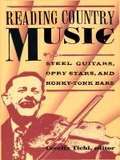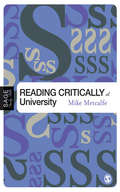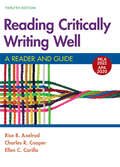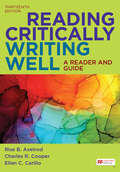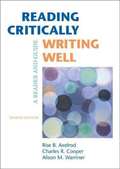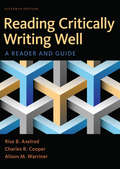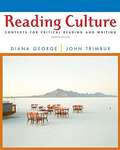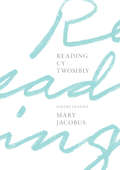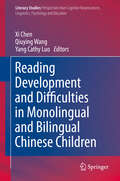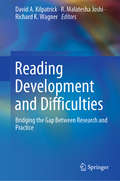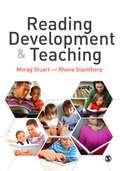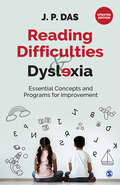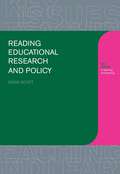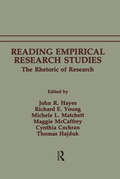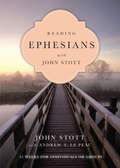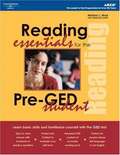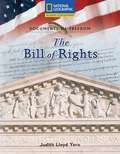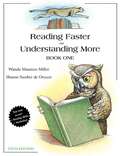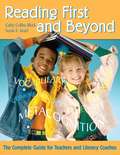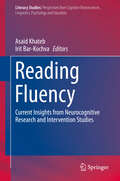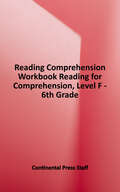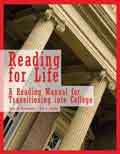- Table View
- List View
Reading Country Music: Steel Guitars, Opry Stars, and Honky Tonk Bars
by Cecelia TichiWith its steel guitars, Opry stars, and honky-tonk bars, country music is an American original. The most popular music in America today, it's also big business. Amazing, then, that country music has been so little studied by critics, given its predominance in American culture. Reading Country Music acknowledges the significance of country music as part of an authentic American heritage and turns a loving, critical eye toward understanding the sweep of this peculiarly American phenomenon.Bringing together a wide range of scholars and critics from literature, communications, history, sociology, art, and music, this anthology looks at everything from the inner workings of the country music industry to the iconography of certain stars to the development of distinctive styles within the country music genre. Essays include a look at the shift from "hard-core" to "soft-shell" country music in recent years; Johnny Cash as lesbian icon; gender, class, and region in Dolly Parton's star image; and bluegrass's gothic tradition. Originally published as a special issue of South Atlantic Quarterly, this expanded book edition includes new articles on the spirituality of Willie Nelson, the legacy and tradition of stringed music, and the revival of Stephen Foster's blackface musical, among others.Contributors. Mary A. Bufwack, Don Cusic, Curtis W. Ellison, Mark Fenster, Vivien Green Fryd, Teresa Goddu, T. Walter Herbert, Christine Kreyling, Michael Kurek, Amy Schrager Lang, Charmaine Lanham, Bill Malone, Christopher Metress, Jocelyn Neal, Teresa Ortega, Richard A. Peterson, Ronnie Pugh, John W. Rumble, David Sanjek, Cecelia Tichi, Pamela Wilson, Charles K. Wolfe
Reading Critically at University (SAGE Study Skills Series)
by Mike MetcalfeHave you ever been asked to critique an article, book, or past project and wondered what exactly was meant by `critique'? This book provides 13 different ways of undertaking a critique. It will help you to confidently use these critique methods to develop your own methods. Each chapter contains sample passages, example critiques and explanations of underlying theory to help you to consolidate your understanding and skills. Reading Critically at University will support undergraduate and postgraduate students across the social sciences, as they master different critique methods. It will also be an excellent resource for all undergraduate study skills modules. SAGE Study Skills are essential study guides for students of all levels. From how to write great essays and succeeding at university, to writing your undergraduate dissertation and doing postgraduate research, SAGE Study Skills help you get the best from your time at university.
Reading Critically, Writing Well with 2020 APA and 2021 MLA Updates: A Reader and Guide
by Rise B. Axelrod Charles R. Cooper Ellen CarilloThis ebook has been updated to provide you with the latest guidance on documenting sources in MLA style and follows the guidelines set forth in the MLA Handbook, 9th edition (April 2021).Reading Critically, Writing Well is a diverse collection of readings from established, emerging, and student writers, combined with expert support for writing across genres. The readings aim to inspire engaged reading, spark curious conversations, and provoke thoughtful writing. Reading Critically, Writing Well provides both the readings and the support you need to make effective rhetorical choices in your own writing.
Reading Critically, Writing Well: A Reader and Guide
by Rise B. Axelrod Charles R. Cooper Ellen CarilloReading Critically, Writing Well, provides the support you need for read-writing connections to succeed in college and beyond.
Reading Critically, Writing Well: A Reader and Guide (8th edition)
by Rise B. Axelrod Charles R. Cooper Alison M. WarrinerThis book teaches you how to analyze the writing of others (both professional writers and students) and then how to apply what you learn to your own writing. For each of the eight common kinds of writing that you will be asked to do in college, ranging from autobiography and reflection to evaluation and argument, this book provides a Guide to Reading, a Guide to Writing, and six essays to serve as models.
Reading Critically, Writing Well: A Reader and Guide, 11e
by Rise B. Axelrod Charles R. Cooper Alison M. WarrinerWith more critical reading coverage than any other composition reader, Reading Critically, Writing Well helps students read for meaning and read like a writer, and it guides them to use what they've learned in their writing. Each of the book’s 8 assignment chapters includes a specific guide to reading that challenges students to analyze the authors’ techniques as well as a step-by-step guide to writing and revising that helps them apply these techniques to their own essays. Now with more readings in each chapter, including 17 provocative new professional selections and student models covering a range of disciplines, this new edition features hands-on activities for critical analysis and invention, helpful reading and research strategies (including 2016 MLA coverage), and multiple opportunities for summary and synthesis. Accessible instruction, engaging readings, and effective writing assignments make Reading Critically, Writing Well ideal for instructors who want the support and readings to demonstrate effective rhetorical choices that students can make in their own writing.
Reading Culture: Contexts for Critical Reading and Writing
by Diana George John TrimburAcclaimed for its compelling readings and provocative images,Reading Culture provides students with outstanding instruction on how to read and write critically about the culture that surrounds them.
Reading Cy Twombly: Poetry in Paint
by Mary JacobusMany of Cy Twombly's paintings and drawings include handwritten words and phrases--naming or quoting poets ranging from Sappho, Homer, and Virgil to Mallarmé, Rilke, and Cavafy. Enigmatic and sometimes hard to decipher, these inscriptions are a distinctive feature of his work. Reading Cy Twombly poses both literary and art historical questions. How does poetic reference in largely abstract works affect their interpretation?Reading Cy Twombly is the first book to focus specifically on the artist's use of poetry. Twombly's library formed an extension of his studio and he sometimes painted with a book open in front of him. Drawing on original research in an archive that includes his paint-stained and annotated books, Mary Jacobus's account--richly illustrated with more than 125 color and black-and-white images--unlocks an important aspect of Twombly's practice.Jacobus shows that poetry was an indispensable source of reference throughout Twombly's career; as he said, he "never really separated painting and literature." Among much else, she explores the influence of Ezra Pound and Charles Olson; Twombly's fondness for Greek pastoral poetry and Virgil's Eclogues; the inspiration of the Iliad and Ovid's Metamorphoses; and Twombly's love of Keats and his collaboration with Octavio Paz.Twombly's art reveals both his distinctive relationship to poetry and his use of quotation to solve formal problems. A modern painter, he belongs in a critical tradition that goes back, by way of Roland Barthes, to Baudelaire. Reading Cy Twombly opens up fascinating new readings of some of the most important paintings and drawings of the twentieth century.
Reading Development and Difficulties in Monolingual and Bilingual Chinese Children
by Xi Chen Qiuying Wang Yang Cathy LuoThis volume explores Chinese reading development, focusing on children in Chinese societies and bilingual Chinese-speaking children in Western societies. The book is structured around four themes: psycholinguistic study of reading, reading disability, bilingual and biliteracy development, and Chinese children's literature. It discusses issues that are pertinent to improving language and literacy development, and complex cognitive, linguistic, and socio-cultural factors that underlie language and literacy development. In addition, the book identifies instructional practices that can enhance literacy development and academic achievement. This volume offers an integrative framework of Chinese reading, and deepens our understanding of the intricate processes that underlie Chinese children's literacy development. It promotes research in reading Chinese and celebrates the distinguished and longstanding career of Richard C. Anderson.
Reading Development and Difficulties: Bridging the Gap Between Research and Practice
by R. Malatesha Joshi David A. Kilpatrick Richard K. WagnerThis book provides an overview of current research on the development of reading skills as well as practices to assist educational professionals with assessment, prevention, and intervention for students with reading difficulties. The book reviews the Componential Model of Reading (CMR) and provides assessment techniques, instructional recommendations, and application models. It pinpoints specific cognitive, psychological, and environmental deficits contributing to low reading skills, so educators can accurately identify student problems and design and implement appropriate interventions. Chapters offer methods for assessing problems in decoding, word and sound recognition, and comprehension. In addition, chapters emphasize the recognition of student individuality as readers and learners, from understanding distinctions between difficulties and disabilities to the effects of first-language orthography on second-language learning. Topics featured in this book include:Learning the structure of language at the word level.Reading comprehension and reading comprehension difficultiesAssessing reading in second language learners.Effective prevention and intervention for word-level reading difficulties.The neurobiological nature of developmental dyslexia. Reading Development and Difficulties is a must-have resource for researchers, practitioners, and graduate students in varied fields, including child and school psychology; assessment, testing, and evaluation; social work; and special education. "I think the book has the potential to be a game changer. It will certainly challenge the expectations of policy makers, not to mention the teachers of beginning readers. These chapters will enhance the knowledge base of those in our schools who are charged with the lofty task of assuring that children have the best possible opportunities to acquire the skill of reading.” Sir Jim RoseChair and author of Independent Review of the Teaching of Early Reading: Final Report (2006)
Reading Development and Teaching (Discoveries & Explanations in Child Development)
by Professor Rhona Stainthorp Morag StuartThis textbook will prove invaluable to teacher educators, teachers, educational psychologists, and any professional who is involved with teaching children to read. It provides a detailed examination of the processes that are involved in achieving fluent word reading skills and ability to comprehend written texts. Understanding these processes and their development empowers teachers to select appropriate, evidence-based teaching strategies and thus teach children more effectively. The book is in four parts: Part 1 provides the reader with a Tutorial Review covering essential knowledge about language, and presenting the two dimensions of the Simple View of Reading. Part 2 concentrates on the word reading dimension, with chapters on processes in skilled word reading, the development of these processes, and practical advice on research validated teaching methods to develop children’s word reading skills. Part 3 turns to the language comprehension dimension, with chapters on the comprehension of oral and written language, and on teaching reading comprehension. Part 4 introduces the reader to assessment practices and methods of identifying children with difficulties in either or both dimensions of the Simple View, and considers children with word reading difficulties and children with specific comprehension difficulties, describing effective evidence-based interventions for each type of difficulty.
Reading Development and Teaching (Discoveries & Explanations in Child Development)
by Morag Stuart Rhona StainthorpThis textbook will prove invaluable to teacher educators, teachers, educational psychologists, and any professional who is involved with teaching children to read. It provides a detailed examination of the processes that are involved in achieving fluent word reading skills and ability to comprehend written texts. Understanding these processes and their development empowers teachers to select appropriate, evidence-based teaching strategies and thus teach children more effectively. The book is in four parts: Part 1 provides the reader with a Tutorial Review covering essential knowledge about language, and presenting the two dimensions of the Simple View of Reading. Part 2 concentrates on the word reading dimension, with chapters on processes in skilled word reading, the development of these processes, and practical advice on research validated teaching methods to develop children’s word reading skills. Part 3 turns to the language comprehension dimension, with chapters on the comprehension of oral and written language, and on teaching reading comprehension. Part 4 introduces the reader to assessment practices and methods of identifying children with difficulties in either or both dimensions of the Simple View, and considers children with word reading difficulties and children with specific comprehension difficulties, describing effective evidence-based interventions for each type of difficulty.
Reading Difficulties and Dyslexia: Essential Concepts and Programs for Improvement
by J.P. DasPreviously, dyslexia was defined as primarily a deficit at the word reading level. When the original edition of this book was published, the core deficit was thought to be phonological coding. The search for a single factor for dyslexia is no longer pursued. However, we must explore why approximately 15 per cent of school children have difficulties in learning to read or doing math. This updated edition offers an explanation based on contemporary developments in the study of cognition and neuroscience. It also studies the impact of poverty on learning, a relatively new but extremely important area of interest. Going beyond a simple view of reading and math, Reading Difficulties and Dyslexia discusses distal factors such as cognitive flexibility and attentional control. A distinguishing feature of this book is that it presents intervention programmes, based on the distal factors, which can greatly improve word decoding and comprehension, and enhance number sense.
Reading Diversity through Canadian Picture Books
by Ingrid Johnston Joyce BainbridgeWhat is the value of picture books in educating a diverse society? This collection of original essays explores how preservice teachers from faculties of education across Canada engage with issues of diversity and national identity as represented in children's picture books. Based on research drawn from education courses and student teaching experiences, the book illustrates new and culturally relevant approaches to curricula that meet the needs of increasingly diverse student bodies.The volume focuses on picture books as a central body of texts, drawing on recent reading theory and exploring the implications of bringing the works into school classrooms. Together, the essays offer a unique cross-Canada perspective on how picture books can help students and teachers explore identities, uncover personal and national histories, and locate a sense of place.
Reading Educational Research and Policy (Learning About Teaching Ser.)
by David ScottReading Educational Research and Policy will improve the ability of teachers to deconstruct policy, research and media texts. This accessible book examines in turn the message systems through which educational meanings are conveyed in modern society: official policy texts; written media and spoken media. Through understanding how and why messages are conveyed, teachers will develop strategies for becoming more critical and reflective of the texts that confront them in their work.
Reading Empirical Research Studies: The Rhetoric of Research
by John R. Hayes, Richard E. Young, Michele L. Matchett, Maggie McCaffrey, Cynthia Cochran, Thomas HajdukFor the most part, those who teach writing and administer writing programs do not conduct research on writing. Perhaps more significantly, they do not often read the research done by others because effective reading of articles on empirical research requires special knowledge and abilities. By and large, those responsible for maintaining and improving writing instruction cannot -- without further training -- access work that could help them carry out their responsibilities more effectively. This book is designed as a text in graduate programs that offer instruction in rhetoric and composition. Its primary educational purposes are: * to provide models and critical methods designed to improve the reading of scientific discourse * to provide models of effective research designs and projects appropriate to those learning to do empirical research in rhetoric. Aiming to cultivate new attitudes toward empirical research, this volume encourages an appreciation of the rhetorical tradition that informs the production and critical reading of empirical studies. The book should also reinforce a slowly growing realization in English studies that empirical methods are not inherently alien to the humanities, rather that methods extend the power of humanist researchers trying to solve the problems of their discipline.
Reading Ephesians with John Stott: 11 Weeks For Individuals Or Groups (Reading The Bible With John Stott Ser.)
by John StottThe Message of Ephesians
Reading Essentials For The Pre-GED Student
by Melissa L. Masi Stephanie SmithPart of the five-book Essentials for the Pre-GED Student series, Reading Essentials reviews the fundamentals for students like you who need extra help with their reading comprehension skills. There is both a pretest and a posttest to determine your strengths and weaknesses. The lessons are written in an easy-to-read format, and this unique guide is sure to help you gain the skills you need to prepare for the GED.
Reading Expeditions (Social Studies: The Bill of Rights 1st Edition
by Judith Lloyd Yero National Geographic Learning StaffLearn the history behind the first ten amendments to the U. S. Constitution. See how the Bill of Rights guarantees Americans five basic freedoms (speech, press, religion, assembly, and petition) and protects the rights of the accused.
Reading Faster And Understanding More
by Wanda M. Miller Sharon Steeber De OrozcoStrategies for improving reading speed and comprehension.
Reading Faster and Understanding More
by Sharon Steeber De Orozco Wanda Maureen MillerThe Reading Faster, Understanding More developmental workbooks recognize the inseparable links between comprehension, vocabulary and reading rate. With vocabulary and study skills instruction integrated throughout, each chapter guides students through the reading comprehension and rate improvement processes and includes exercises to practice these skills. Book 1 features lively readings-from the 6th to 8th grade level--on the Fry test, with the "textbook" chapter at the 9th grade level. For anyone interested in reading comprehension.
Reading First and Beyond: The Complete Guide for Teachers and Literacy Coaches
by Cathy Collins Block Susan E. IsraelPacked with enriching ideas for all educators, this guide summarizes the key areas of the Reading First program to provide a comprehensive understanding of its components.
Reading Fluency
by Asaid Khateb Irit Bar-KochvaThe book is dedicated to the blessed memory of Prof. Zvia Breznitz, whose groundbreaking research has made a tremendous impact on the understanding of fluency in reading. The book presents a multidimensional perspective of recent research and reviews on fluency in reading. The first part presents recent brain-imaging findings from studies into the neurobiological basis of reading, as well as cognitive and language studies exploring the underlying factors of fluency in reading and its development. The second part comprises reviews of intervention studies that address reading ability, and in particular, fluency in reading. The book provides a unique multilingual perspective on reading research by including studies of readers of different orthographies and speakers of different languages. Both scientists exploring the different aspects of reading and language, and clinicians of reading intervention will find this book not only of great interest but extremely useful in its clear and in-depth presentation of current reading research.
Reading For Comprehension: Level F
by Continental Press StaffHow does an IMAX movie work? With level F of Reading for Comprehension, your students will learn all about this kid-friendly topic and many more. This book for grade 6 students includes 46 high-interest, nonfiction articles with questions that reinforce key reading and writing skills commonly found on state tests. Multiple-choice questions test these reading skills: vocabulary, main idea and details, sequence, cause and effect, and inferences and conclusions. Students also answer open-ended questions to practice writing narrative text, descriptive text, persuasive text, and expository text.
Reading For Life: A Reading Manual For Transitioning Into College
by Faith Christiansen Judi QuimbyA study guide for: Tuesdays with Morrie The Last Lecture We Beat the Streets Learning from the Heart
